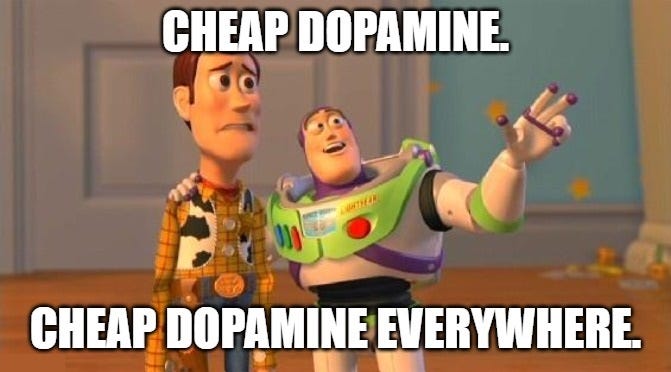Modern Madness: Dopamine Dopeheads
The modern mind is being slapped around by dopamine like a cheap whore.
The Dopamine Problem
Dopamine is the “feel good” neurochemical released in our brains whenever we do something pleasurable. Consequently, it’s a powerful motivator for us as people. In other words, dopamine plays a crucial part in our brain’s natural reward system. However, like with anything, overindulgence can be incredibly harmful.
Dopamine is a chemical produced by our brains that plays a starring role in motivating behavior. It gets released when we take a bite of delicious food, when we have sex, after we exercise, and, importantly, when we have successful social interactions. In an evolutionary context, it rewards us for beneficial behaviors and motivates us to repeat them.1
Dopamine can provide an intense feeling of reward.
Dopamine is most notably involved in helping us feel pleasure as part of the brain’s reward system. Sex, shopping, smelling cookies baking in the oven — all these things can trigger dopamine release, or a "dopamine rush."
This feel-good neurotransmitter is also involved in reinforcement. That’s why, once we try one of those cookies, we might come back for another one (or two, or three). The darker side of dopamine is the intense feeling of reward people feel when they take drugs, such as heroin or cocaine, which can lead to addiction.
Dopamine also plays a role in these functions:
learning and attention
mood
movement
heart rate
kidney function
blood vessel function
sleep
pain processing
lactation2
THE HEDONIC TREADMILL
I want you to imagine a man named Bob. Bob works an entry-level office job in the city. He lives in a cramped studio apartment, shops at Goodwill, and drives an old Toyota. Bob’s world is surrounded by corporate advertising egging him on to indulge in the nicer things in life, but he simply can’t afford them. Bob, fed up with his lot in life, starts sending his resume out and eventually lands a new job that almost doubles his income. Bob takes advantage of this new opportunity to move into a one-bedroom apartment, shop at H&M, and buy a Lexus. At this point, Bob’s on cloud nine, but after a while, the shiny new toys he’s bought don’t really excite him anymore. They’re starting to feel normal. Why is that?
Human nature has given us an impressive ability to adapt to different environments. Unfortunately, modern society has us now surrounded by dopamine drivers like junk food, social media, video games, porn, and more. Enter hedonic adaptation, quite possibly our biggest hurdle to achieving dopamine discipline.
“We buy a new house, we get accustomed to it,” says Professor Lyubomirsky, who studies what psychologists call “hedonic adaptation,” a phenomenon in which people quickly become used to changes, great or terrible, in order to maintain a stable level of happiness.3
JUNK FOOD
Sweet, sweet junk food. The bane of my existence. Show me a man who can turn down a free Big Mac, McDonald’s french fries, and a large Coke combo, and I will show you a genetic freak of nature. That shit is DESIGNED to be addictive.
1. Junk food can get you high
The brain has a reward system that hardwires us to want to engage in behaviours that we find pleasurable – like eating tasty foods.
When we eat junk foods the reward circuits within our brains activate and release the chemical dopamine.
Our brains can become overwhelmed by the pleasure from these rewarding foods and in response, the brain adapts and makes more receptors for dopamine.
This means a greater amount of junk food is needed to get the same “kick”, making us eat more, in the same way that an addict develops a tolerance to drugs.
So, our brains are hardwired to seek out and want rewarding foods, making us crave and desire sweet and fatty foods.4
Processed food, he notes, is "inexpensive, it's legal, it's everywhere. And the advertising from the companies is cueing us to remember those products and we want those products constantly. So the food environment ... is one of those key things that makes food even more problematic for so many people."
Moss notes that memory — and nostalgia in particular — play a big role in the foods we crave.
"The soda companies discovered that if they put a soda in the hands of a child when they're at a ballpark with their parents, that soda will forever be associated with that joyous moment," he says. "So later on in life, when that child now wants to experience a joyous moment, they're going to think of soda."
During the pandemic, he says, many people have sought comfort in the snacks they remember from childhood. "We went into the store, and we started buying products we hadn't had since we were kids," he says — recalling "great joyous moments."5
Social Media
I’m trying to build a career as a writer and commentator. I know I’m fucked when it comes to the inevitable brain rot caused by the internet and social media. I am someone you could describe as terminally online. I am also aware that the best solution to that disability is to touch grass, but more on that later.
What makes social media so addictive?
Variably rewarding users with stimuli (likes, notifications, comments, etc.) keeps them engaged with content. When a user’s photo receives a “like,” the same dopamine pathways involved in motivation, reward, and addiction are activated. What keeps us hooked on social media isn’t just the “pleasure rush of the like,” says Johansen, “it’s the intermittent absence of the like that keeps us engaged.”6
The Path Forward
I think you get the point. Also, I’ll be honest. I largely wrote this article because I’m getting fat and I needed some way to help me knock some sense back into my brain. I have my work cut out ahead of me. I’m taking more breaks to do more things like taking naps, going for walks, cooking healthy meals, or anything else that helps me take a break from chasing cheap dopamine. In closing, I leave you with this explanation of UCSF Medical’s Dr. Cameron Sepah’s “dopamine fast” by Harvard Medical’s Dr. Peter Grinspoon.
Thanks for reading. See you next time on Modern Madness.
What Sepah intended with his dopamine fast was a method, based on cognitive behavioral therapy, by which we can become less dominated by the unhealthy stimuli — the texts, the notifications, the beeps, the rings — that accompany living in a modern, technology-centric society. Instead of automatically responding to these reward-inducing cues, which provide us with an immediate but short-lived charge, we ought to allow our brains to take breaks and reset from this potentially addictive bombardment. The idea is that by allowing ourselves to feel lonely or bored, or to find pleasures in doing simpler and more natural activities, we will regain control over our lives and be better able to address compulsive behaviors that may be interfering with our happiness.
The six compulsive behaviors he cites as behaviors that may respond to a dopamine fast are: emotional eating, excessive internet usage and gaming, gambling and shopping, porn and masturbation, thrill and novelty seeking, and recreational drugs. But he emphasizes that dopamine fasting can be used to help control any behaviors that are causing you distress or negatively affecting your life.7
References
Dopamine, Smartphones & You: A battle for your time. Stephen Hartley. Harvard. 2018.
Dopamine: The pathway to pleasure. Stephanie Watson. Harvard. 2021.
But Will It Make You Happy?. Stephanie Rosenbloom. NY Times. 2010.
Five ways junk food changes your brain. Kelly Ryan. RMIT University. 2016.
Cheap, Legal And Everywhere: How Food Companies Get Us 'Hooked' On Junk. Dave Davies. NPR. 2021.
A Psychiatrist’s Perspective on Social Media Algorithms and Mental Health. Tammy Qiu. Stanford. 2021.
Dopamine fasting: Misunderstanding science spawns a maladaptive fad. Peter Grinspoon, MD. Harvard. 2020.








